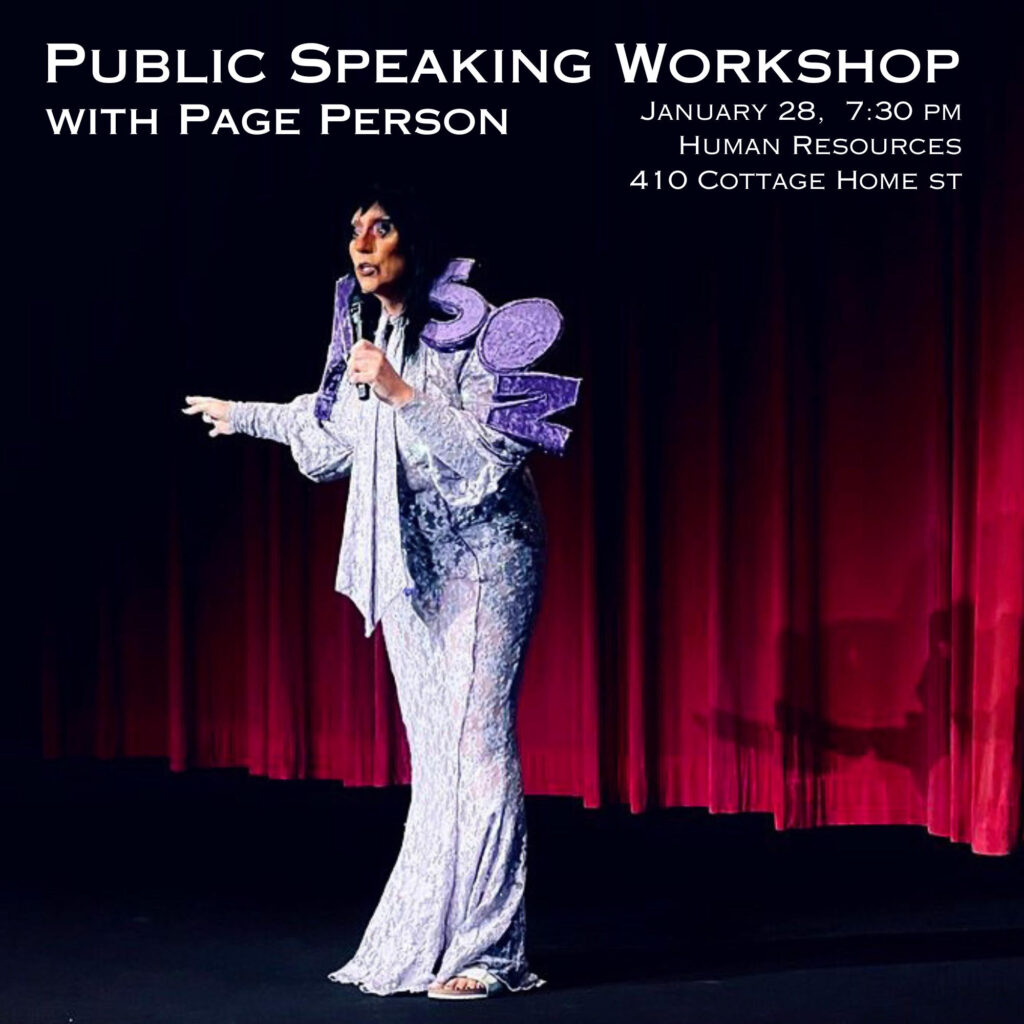
- This event has passed.
PUBLIC SPEAKING WORKSHOP with Page Person
January 28 7:30 pm – 10:00 pm

Purpose: To find comfort in public speaking
PART ONE – THE 5 POINT PLAN
The first half of the event will be a lecture by Page Person on a variety of techniques they have
learned in order to become a confident public speaker. These are arranged in five main
categories:
1. Self image: Participants will be encouraged to remember that when they are in a position to
speak publicly, it is because they are knowledgeable on the topic. We help people by sharing
our experience on a topic we are experienced and engaged with. People want to learn from us.
People want to see us do well. What affirming language can we use about ourselves to
eliminate negative self talk? How can we locate the best version of ourselves when we look in
the mirror? What article of clothing makes us feel powerful? How will we reward ourselves
afterwards?
2. Physical techniques: Participants will be guided through somatic techniques including
breathing exercises and physical grounding to negotiate the physical sensations that arise when
we are about to do something we are afraid to do. By maintaining a practice of intentional
breathing in our daily lives we can apply these tools to manage the way we feel when we
experience stress. Adrenaline is your friend and helps with memory – we all experience
sensations before we go before an audience. Naming this sensation “fear” or “stagefright”
causes us to spiral into panic. Creating a new paradigm, with the understanding that this energy
we feel will be most useful to us while we are speaking, can help diminish the fear response.
Your body language affects how you are perceived.
3. Composition: Writing for the spoken word is fundamentally different than writing for the page.
In this section we will discuss creating an outline to work from, making a diagram of points we
want to make and ensuring that all of our words are supporting these concepts. We will discuss
callbacks, repetition, and ending on a memorable note.
4. Mnemonics: How will you remember what you are going to say? A series of visualization
techniques (constellations, memory palace, physical gestures) combined with rewriting key
points by hand help us feel confident in delivering our material with minimal dependence on
written notes. Improving one’s memory skills will increase one’s ability to make eye contact and
connect with audience members. Think of how easy it is to learn the lyrics of a song: the song
has a structure that connects repeated memorable elements. How can we find a similar
approach to public speaking?
5. Delivery: Participants will be encouraged to speak in their own plain language. Often we feel a
pressure to be perceived as funny or smart and reach for language that does not feel natural for
us. When our mouth gets ahead of our thoughts we tend to resort to filler words (um, uh, so yeah, like) which has the opposite effect. We tend to speak too quickly to be understood in
rooms that have echoes. Intentional pauses give your audience time to absorb a point you have
made. Don’t try to make a joke if you are not funny! If you do make a joke make sure to pause
for laughs. Deliver a complete thought to one person in the audience. Look for who is paying
attention to you and reflect that back. If your audience thinks you could check in on them at any
time they are far less likely to fall into distraction. Things will go wrong! It’s ok! Be thankful for
your listeners’ attention. Rehearse, rehearse, rehearse: don’t practice until you get it right, do it
until you can’t get it wrong.
PART TWO – INTO ACTION
In the second half of the event, participants will put these techniques into action through a series
of prompted exercises. By having these experiences in a more informal setting, they will be able
to form memories of public speaking experiences in which they are supported in reaching
beyond their current comfort level.
-looking into the mirror and liking oneself
-breathing and grounding exercises
-owning the stage/physical confidence
-creative visualization
-introducing oneself
-introducing others
-speaking extemporaneously (draw a topic out of a hat and speak on it)
-speaking from written notes on an area of personal expertise (write a paragraph on something
you know about)
Outcome: Participants will have a set of tools that they can apply to feel confident in public
speaking. Concepts will be put into action to create an experience set based in positive
reinforcement. The workshop is intended to be enjoyable, with the goal of looking forward to
sharing our knowledge and experience with an audience.